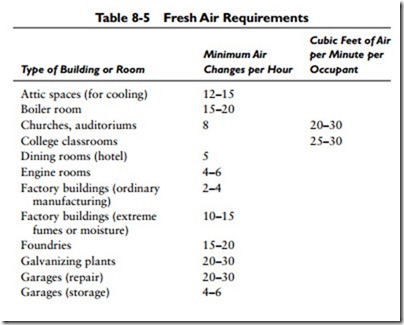Indoor-Outdoor Design Conditions
The indoor and outdoor design conditions must be established before any cooling load calculations can be made. This will be the first step in your procedure. As you will see, the difference between the indoor and outdoor design temperatures will eventually serve as a basis for selecting the correct size air conditioner.
Designing a system to meet the maximum outdoor summer temperature is generally not necessary because these temperatures either rarely occur or occur for a comparatively short duration of time. It is the general practice to design the system for slightly less severe conditions and thereby save on equipment and installation costs.
Ventilation Requirements
Each conditioned space requires a specific amount of outside fresh air to be circulated through it in order to remove objectionable odors (for example, cooking odors, tobacco smoke, body odors) and to maintain comfort standards.
Ventilation standards indicating recommended air changes for a variety of space usages and occupancy have been established by the ASHRAE. Local codes are often based on ASHRAE research and data. These ventilation standards are easy and convenient to use, but are objected to by some authorities because the sources of con- tamination seldom bear any relationship to cubic area.
The air-conditioning system must be capable of supplying enough outside fresh air to maintain air purity and comfort standards. The ventilation requirements for a given structure or space are based either on the desired number of air changes or the number of occupants. The volume rate of ventilation air is expressed in cubic feet per minute (cfm).
According to the ASHRAE, the outside fresh air requirement for both residences and apartments ranges from 10 cfm (minimum) to 20 cfm (recommended). Fresh air requirements for other types of structures are listed in Table 8-5.
The amount of outside fresh air required for each air change per hour equals the amount of inside air that must be removed from the structure or space during the same time span. The following formula can be used to determine the amount of air supplied per minute:
The floor plan of the residence shown in Figure 8-11 contains 740 square feet. The height of each room is 7 feet, which gives an area of 5180 cubic feet.
Table 7-1 in Chapter 7 (“Ventilation and Exhaust Fans”) lists the number of average air changes per minute required for good ventilation for a number of different applications. You will note that each listed air change ranges from a minimum to a maximum number of changes. The rate of air change you select will depend on the following:
1. Geographical location
2. Occupancy
3. Ceiling height
Warmer climates and larger numbers of occupants require a greater rate of air change. Conversely, an 8-foot ceiling will require more ventilation than a 15-foot ceiling.
Using a 3-minute rate of air change for the residence illustrated in Figure 8-11, the required number of air changes necessary to give proper ventilation can be determined as follows:
Thus, 1726.7 cfm is needed to change the air every 3 minutes (or 20 air changes every hour).
Always check the local health department codes or local building codes for required ventilation standards first. If none exist, use the recommended air changes listed in this table, or data available from ASHRAE research.
Related posts:
Incoming search terms:
- inside and outside design conditions
- design conditon of airconditioning
- according to ASHRE the outside fresh air requirement for both residencies and apartments range from 10 to
- selection of outdoor condition for hvac
- outside and inside design of air conditions
- inside and outside design conditions for air conditioning
- inside and outside design conditions for Air
- inside and outside design condition of air conditionr
- inside and outside design condition
- indoor design condition in air balancing
- hvac air changes per hour chart
- design conditions in ac system
- deisgn condition in air conditioner
- Air Conditioning Systems mail
- air conditioning design conditions
- Air conditioning aeration and ventilation equipment mail
- What are the design conditions for air conditioning?

